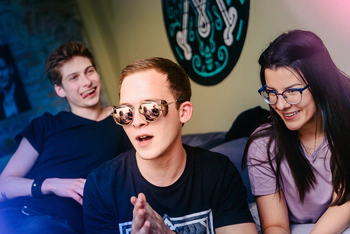New Study Shows LSD Experimentation More than Quadrupled Among Young Adults from 2002 to 2019
LSD has surged in popularity among young people, putting them at risk for harmful side effects and exposure to other addictive drugs. Fast action must be taken to halt a reignited LSD experimentation wave.

For some time, there’s been a belief that LSD is a “drug of the past,” a drug that previous generations experimented with but which “isn’t popular today.” However, recent findings have thoroughly debunked that view. LSD experimentation is rising dramatically, particularly among adults ages 18 to 25.
In 2002, fewer than 1% of young people experimented with LSD. Today, more than 4% do. That 4x increase indicates an exponential spread of LSD popularity, likely due to peer pressure, group drug use environments, and a perceived drop in LSD risk.
Beyond LSD, reports suggest other hallucinogens are becoming more popular, particularly psilocybin.
These drugs are not harmless, and a surge in their use is sure to result in unwanted side effects and an onset of compulsive drug-using habits among young people.
What the Recent Findings Show
Researchers at Columbia University’s Mailman School of Public Health in New York City found that among people ages 18 to 25, LSD usage rose from less than 1% in 2002 to 4% in 2019. Overall, 5.5 million Americans experiment with some hallucinogen. The researchers believe that an increase in hallucinogen use directly results from younger generations having a low perception of drug risk. That lower perception of risk may result from some health officials believing LSD and other hallucinogens may have health benefits. This controversial view has gained some attention in recent years.1

Another recent paper in the Journal of Psychedelic Studies estimated that about 9.68% of young people report having tried psilocybin at least once.2 The findings published by Columbia University and this latest research put forth in the Journal of Psychedelic Studies mirror recently published research from the National Institutes of Health that suggests all forms of hallucinogens are becoming more popular among young people.3 Further, the NIH concluded that a 4% usage rate is likely a grave underestimate of the real rate of hallucinogen use among young people. According to NIH data, hallucinogen use among young adults 19 to 30 reached historic highs, with 8% of young adults reporting use. That’s the highest rate of hallucinogen use since 1988. For comparison, only 5% of young adults reported using hallucinogens in 2016. Only 3% reported using such drugs in 2011.
Finally, NCBI research reported that over 30 million people in the United States have used hallucinogenic drugs at least once. That makes hallucinogens one of the nation’s most widespread drug types.4
These are no longer “drugs of the past.”
LSD and Psilocybin Defined
Hallucinogens are a diverse group of drugs. Though there are many types of hallucinogens, they all accomplish a similar effect, i.e., altering the user’s awareness and perceptions. When using hallucinogens, one might feel like they are in a completely different world and may even begin dissociating (disconnecting or separating from reality).
LSD is one of the most powerful mind-altering chemicals ever made. A synthetic substance made in labs, LSD is a clear or white odorless material made from lysergic acid. Lysergic acid can be obtained from a fungus that grows on rye and other grains. LSD usually appears in paper-like tablets that users dissolve on their tongues.
Psilocybin is a naturally-occurring drug, a plant-based substance. Psilocybin comes from certain mushrooms and fungi found in tropical and subtropical regions of South America, Mexico, and the United States. The mind-altering substance can be found in mushrooms growing in nature. Such mushrooms can also be grown in laboratories or home gardens.
Other types of hallucinogens include:
- Peyote, a small, spineless cactus with mescaline as its main ingredient
- 251-NBOMe, a synthetic hallucinogen with similar properties to LSD and MDMA
- DMT, an active ingredient in Ayahuasca and a powerful chemical found naturally occurring in some Amazon plants
Dissociative drugs with hallucinogenic properties include:
- PCP, initially an anesthetic for surgery, is now used as an illicit mind-altering substance found in powder, liquid, or crystal form
- Ketamine, once a surgery anesthetic, is now used as an illegally synthesized and sold on the black market as a date-rape drug
- Salvia, a plant common to Central and South America, can cause dissociation when chewed, smoked, or brewed
- DXM, an OTC cough suppressant, can produce mind-altering effects when misused
The Harmful Effects of Hallucinogens

It’s important to mention that increasing reports suggest hallucinogenic drugs are mixed with fentanyl without users knowing. Pat Aussem, associate vice president for consumer clinical content development at the Partnership to End Addiction, highlighted that concerning factor when reviewing the research out of Columbia University. In Aussem’s own words, “While many hallucinogens are designated as Schedule 1 drugs with ’no currently accepted medical use,’ they are increasingly being discussed on social media, at research institutes, and in other forums as alternatives to more traditional pharmaceuticals for certain mental health problems. It is especially important to note that street MDMA has been laced with fentanyl, a powerful pain reliever that is driving skyrocketing overdoses in our country.” With that in mind, even if young people use hallucinogens because they think they may have some health benefits, they may actually be using a very different, potentially lethal drug.5
“It is especially important to note that street MDMA has been laced with fentanyl, a powerful pain reliever that is driving skyrocketing overdoses in our country.”
The list of potential harmful effects of experimenting with hallucinogens is long. Common side effects include:
- Increased heart rate
- Nausea and vomiting
- Loss of perception and reality
- Increased blood pressure and breathing rate
- Increased body temperature to the point of fever
- Loss of appetite, uncoordinated movements, sleep problems
- Dry mouth, excessive sweating, panic, paranoia, psychosis, bizarre behavior
When people use hallucinogens repeatedly, the drugs can have permanent detrimental effects. Some users fall into persistent psychosis, mental problems for which there is no cure. One such psychosis is called Hallucinogen Persisting Perception Disorder, a disorder involving flashbacks, recurring hallucinations, and other visual disturbances.
The Importance of Seeking Treatment
Young people should avoid hallucinogenic drugs. Such substances have zero health benefits and a long list of risks and potential harm. Further, when someone begins using drugs and cannot stop using them on their own, they need to seek help at a qualified residential drug treatment center. If you know someone who is using hallucinogens, make sure they get help. Don’t let them lose hold of reality, or potentially lose their life, to drugs.
Sources Cited:
-
WOL. “Adolescent and adult time trends in US hallucinogen use, 2002–19: any use, and use of ecstasy, LSD and PCP.” Wiley Online Library, 2022. onlinelibrary.wiley.com ↩︎
-
AKJournals. “Use of psilocybin (“mushrooms”) among US adults: 2015–2018.” Journal of Psychedelic Studies, 2021. akjournals.com ↩︎
-
NIH. “Marijuana and hallucinogen use among young adults reached all-time high in 2021.” National Institutes of Health, 2021. nih.gov ↩︎
-
NLM. “Over 30 million psychedelic users in the United States.” National Library of Medicine, 2013. ncbi.nih.gov ↩︎
-
USNews. “LSD Is Making a Comeback Among Young Americans.” U.S. News, 2022. usnews.com ↩︎






 ®
®